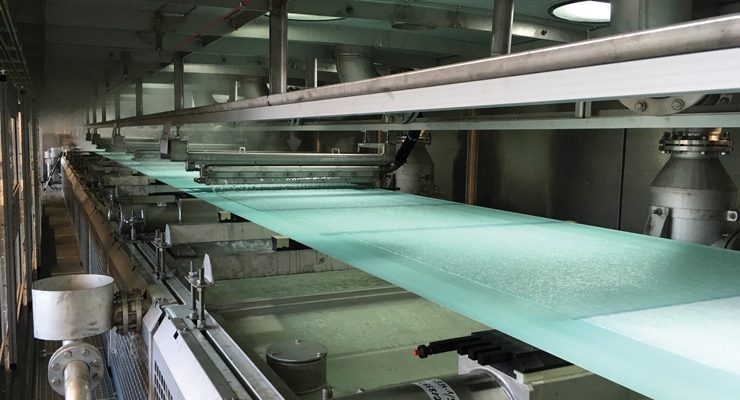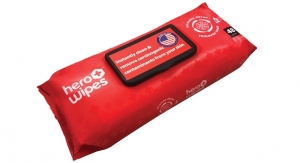Karen McIntyre, Editor11.02.18
Lenzing has pioneered a new technology platform, Lenzing Web Technology, allowing the manufacturer of cellulosic based fibers to open up new market opportunities for the industry. The €26 million project has been in the works since 2015 after Lenzing noticed the potential nonwovens, which represents about 30% of its sales, has on its business.
“Our customer base is strong,” says CCO Robert van de Kerkhof. “We have opportunities to grow more in what we are doing and continue to grow with our sustainable technology using Lyocell and much more advanced progress, by going into new applications that we cannot go into with our current technology.”
Lenzing recently completed work on a one-meter wide pilot facility featuring the web forming technology at its headquarters in Lenzing, Austria. The technology starts with wood pulp and produces a nonwoven fabric made of 100% continuous Lyocell filament. This web can be integrated with standard non-thermal based nonwoven bonding technologies such as hydroentangling and needlepunch. The technology also enables a unique self-bonding mechanism where filaments bond into a fabric during the laydown process. This mechanism enables a product range with a much wider variety of surface textures, drapeabilty and dimensional stability than other nonwovens technologies using 100% cellulosic fibers.
“If you look in our industry there is usually a lot of material blends used and very few examples of 100% based on renewable resources…what we call cellulose fibers or wood based fibers,” van de Kerkhof says. “This is one of the drivers to develop such a technology that you have a 100% wood based product.”
While still in the early stages of seeing what the technology means for nonwovens, van der Kerkhof says cost considerations will likely make the technology suitable for advanced applications in technical fields or higher priced wipes —areas where Lenzing’s fibers are already valued for their sustainability contribution.
“The technology is in line with our strategy to feed the whole supply chain of our market,” van de Kerkhof says. “Lenzing is building on the success of its fiber production by looking strongly downstream at significant capacities internally by talking to the customers of our customers and even up to retail level and exploring opportunities to retail outlets.”
The installation of a commercial line for the technology is still a few years away, says global business development manager, Tom Carlyle. “This is really just now the beginning,” he says. “We have certain patents that are linked. We continue to optimize the process, work with development partners, and work on finalizing the costs.”
As Lenzing works with potential partners to see what this technology can bring to their businesses, its engineers will in parallel work on what a line like this can look like on a commercial scale.
Carlyle adds: “We’re not just focusing on developing a technology and offering the product to everyone on the market. We are taking more of a of a partnership driven approach where we look for potential business partners that have similar long-term goals and want to work together to develop and bring these sustainability industry solutions to the market.”
“Our customer base is strong,” says CCO Robert van de Kerkhof. “We have opportunities to grow more in what we are doing and continue to grow with our sustainable technology using Lyocell and much more advanced progress, by going into new applications that we cannot go into with our current technology.”
Lenzing recently completed work on a one-meter wide pilot facility featuring the web forming technology at its headquarters in Lenzing, Austria. The technology starts with wood pulp and produces a nonwoven fabric made of 100% continuous Lyocell filament. This web can be integrated with standard non-thermal based nonwoven bonding technologies such as hydroentangling and needlepunch. The technology also enables a unique self-bonding mechanism where filaments bond into a fabric during the laydown process. This mechanism enables a product range with a much wider variety of surface textures, drapeabilty and dimensional stability than other nonwovens technologies using 100% cellulosic fibers.
“If you look in our industry there is usually a lot of material blends used and very few examples of 100% based on renewable resources…what we call cellulose fibers or wood based fibers,” van de Kerkhof says. “This is one of the drivers to develop such a technology that you have a 100% wood based product.”
While still in the early stages of seeing what the technology means for nonwovens, van der Kerkhof says cost considerations will likely make the technology suitable for advanced applications in technical fields or higher priced wipes —areas where Lenzing’s fibers are already valued for their sustainability contribution.
“The technology is in line with our strategy to feed the whole supply chain of our market,” van de Kerkhof says. “Lenzing is building on the success of its fiber production by looking strongly downstream at significant capacities internally by talking to the customers of our customers and even up to retail level and exploring opportunities to retail outlets.”
The installation of a commercial line for the technology is still a few years away, says global business development manager, Tom Carlyle. “This is really just now the beginning,” he says. “We have certain patents that are linked. We continue to optimize the process, work with development partners, and work on finalizing the costs.”
As Lenzing works with potential partners to see what this technology can bring to their businesses, its engineers will in parallel work on what a line like this can look like on a commercial scale.
Carlyle adds: “We’re not just focusing on developing a technology and offering the product to everyone on the market. We are taking more of a of a partnership driven approach where we look for potential business partners that have similar long-term goals and want to work together to develop and bring these sustainability industry solutions to the market.”











